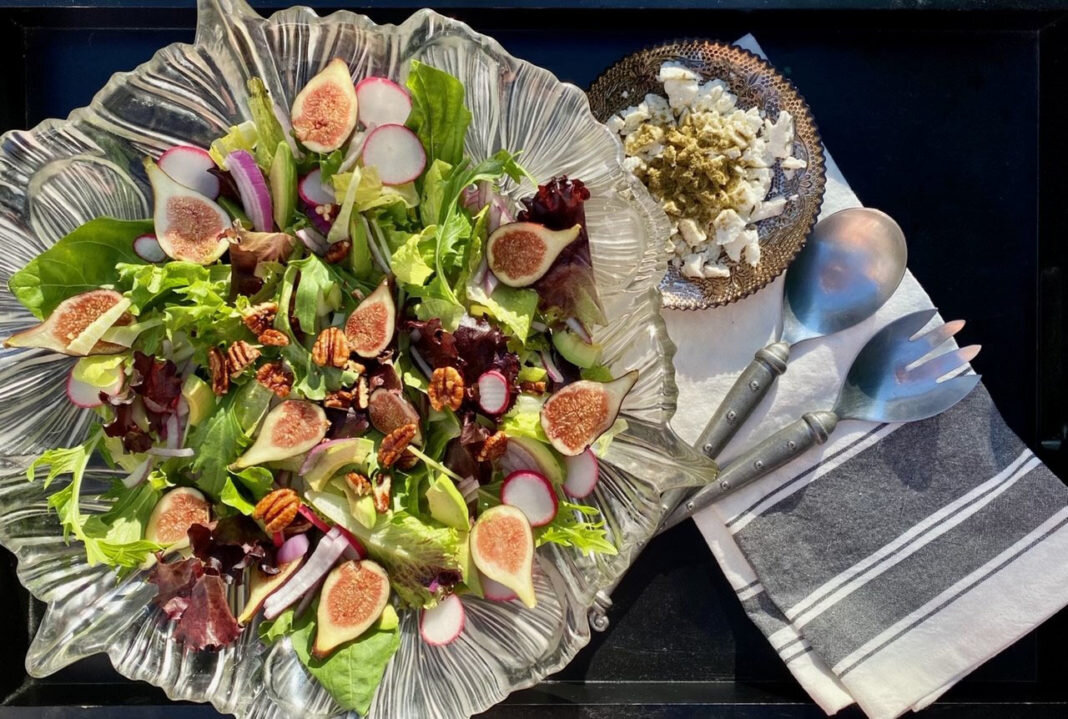Fresh figs are a deliciously romantic addition to desserts, cheese boards, tarts and salads.

Lovely and luscious, figs are one of those ephemeral delights of the summer, only in season from June to October.
With their dark and dusky, soft velvety skin, their honey-sweet, berry-flavored, silky pink flesh filled with tiny seeds, their syrupy nectar and their blossom scent, the fig is truly the most sensual of fruits.
Commenting on the book of Genesis, the Sages state that it is the fig that is the forbidden fruit from the Tree of the Knowledge of Good and Evil. After the sin of eating the fruit in the Garden of Eden, Adam and Eve cover their nakedness with fig leaves. And when the Book of Deuteronomy describes the abundance and fruitfulness of the Land of Israel, the fig is listed as one of the seven species.
The fig tree has been a symbol of peace and prosperity since the times of the prophets, “Each man under his own vine and fig tree” (Micah 4:4). George Washington cites this biblical metaphor in his letter of 1790 to Touro Synagogue to symbolize the equality of all Americans. When Theodore Herzl imagines a Jewish Homeland, he invokes this image of fig trees and grapevines from the First Book of Kings, where “Judah and Israel will dwell securely.”
Figs were the first plant cultivated by humans, even before wheat and barley, in the Jordan Valley of Israel. Figs were cultivated all over the Middle East and the Mediterranean, from Afghanistan to India to Portugal. Extolled for their great health benefits figs were an important part of the diets of both the Ancient Greeks and Romans, and of their mythology. Figs were linked to Demeter, the Greek goddess of fertility and agriculture and were an offering to the Roman god Bacchus.
Legend has it that the first Roman emperor Augustus was poisoned by figs from his own garden by his wife Livia, who smeared poison on them. In her honor, a variety of figs called the Liviana was cultivated in Roman gardens.
The Spaniards brought figs to the New World. In 1768, the Spanish priest and friar Junipero Serra and his Franciscan missionaries introduced figs to California. As they made their way north along the coast, they established 21 missions and at each one they planted fig trees from seeds they had cultivated. We are still eating the fruits of their labor in the popular Mission figs, with their black and purple skin and their deep, earthy flavor.
Fresh figs are a deliciously romantic addition to desserts, cheese boards, tarts and salads. We offer you a simple, sublime recipe for a wonderful fig salad and a refreshing balsamic vinaigrette dressing.
Bon Appetit!
Fig Salad Recipe
10 cups organic mixed baby greens
1 small purple onion, finely sliced
10 ripe figs, cut in half
6 small radishes, finely sliced
1 cup candied pecans
1/2 cup crumbled feta cheese (optional)
Dressing
1/2 cup extra-virgin olive oil
1/3 cup balsamic vinegar
1 tablespoon honey
1 tablespoon minced shallot
Dash of salt and Pepper
Place all the ingredients in a large salad bowl.
Dress with the vinaigrette just before serving.

